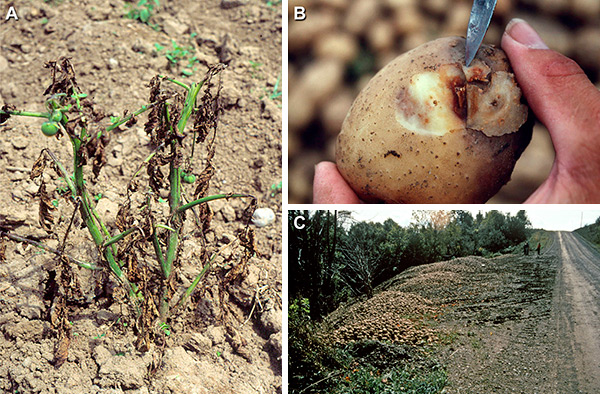Saving One Potato, Two Potatoes – and More from Late Blight
 |
|
Because potato late blight devastates both the plant (A) and tuber (B), growers discard affected crops into cull piles (C). BlightPro forecasts late blight occurrence, warning growers of potential outbreaks. Photos: Fry Lab, Cornell University. |
Late blight is the number one disease risk on 1.2 million acres of U.S. potatoes, and it’s a serious concern for growers of 400,000 acres of tomatoes. The culprit is the same pathogen that contributed to the Irish potato famine: Phytophthora infestans, adept at infecting tubers and plants from year to year. Because no rescue techniques are available, prevention is the best cure. When the weather favors late blight, many growers hedge their bets by applying fungicides proactively, even if the pathogen isn’t local.
Three decades ago, Cornell University plant pathologist William Fry and his colleagues were developing a way to determine the timing of late blight outbreaks in potato and tomato so growers could spray fungicides only when needed. What they had found by 2010, combined with advances in computing technology and access to specific weather data, now enabled Fry to go further. With a two-year, $88,392 RIPM research grant, he and Pamela Roberts from the University of Florida teamed up on Decision Support System for Tomato and Potato Late Blight. They expanded the web-based decision support system (DSS) from potatoes to tomatoes, incorporating fungicides with low environmental impact. In the process, they created a smart phone app and developed a model that could predict the need for fungicide application. The system has been used effectively from Florida to New York.
And they kept rolling. Today about 4,000 potato growers in New York have benefited from their forecasting and alert program—dubbed BlightPro DSS—an interactive system that helps users make well-informed decisions about when to protect crops. BlightPro bases recommendations on data from the National Weather Service, the late-blight resistance of the potato or tomato cultivar, proximity to an inoculum source, and the fungicides available to the grower. Consultants and growers can receive emails or text messages about high risk conditions for late blight. Says Fry, “Use of the DSS has increased over the years. Growers like the fact that BlightPro can reduce their risk of crop loss, and it has the potential to reduce fungicide use by an average of 10–20%.”
Fry and Roberts are continuing their research as part of a team that received a $9 million AFRI grant in 2011. “Having the DSS and demonstrating it was crucial to getting the proposal funded,” says Fry. The next frontier? Ground-truthing the presence of late blight with early-warning sensors in the field that “smell” the volatiles late blight emits.
— by CARRIE KOPLINKA-LOEHR
